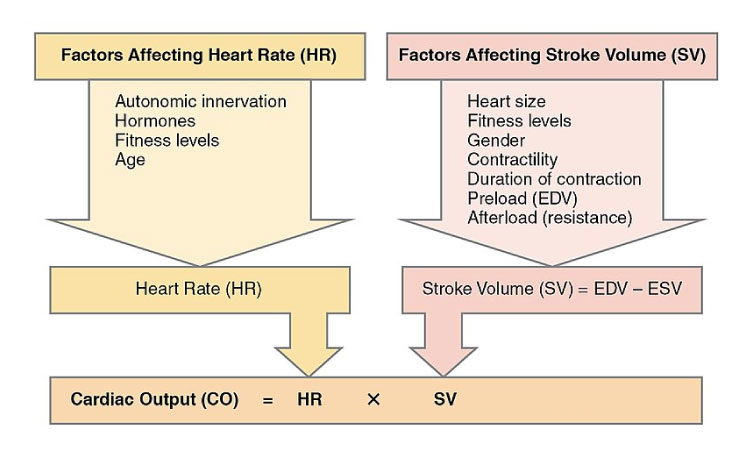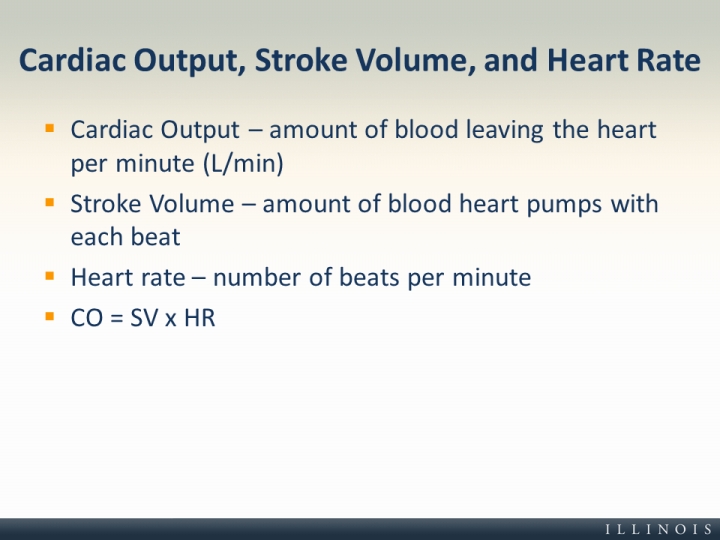Cardiac Output Is Equal to Which of the Following
In order for blood to enter the heart the atria must be in diastole and the pressure in the atria must be lower than in the veins. Times divided by plus minus.

Cardiac Output Definition Factors Affecting Cardiac Index
The normal cardiac output is about 5 litersventricleminute.

. Cardiac output is _____. Each of the following factors will increase cardiac output except Each of the following factors will increase cardiac output except increased heart rate. Cardiac output is calculated via the following formula.
Cardiac output is equal to stroke volume _____ heart rate. Thus giving the formula. The equation for cardiac output is.
C the difference between the end-diastolic volume and the end-systolic volume. Cardiac Output CO HR x SV. Cardiac output is _______.
End diastolic volume end systolic volume. Cardiac output expressed in litersminute is the amount of blood the heart pumps in 1 minute. HR is determined by signals from the sinoatrial node which automatically depolarizes at an intrinsic rate of 60 to 100 times each minute.
According to Starlings law of the heart the cardiac output is directly related to the. Stroke volume is the volume of blood ejected by the ventricles during each contraction. The average cardiac output for an adult is about 5-8 litres blood in per minute.
Stroke volume SV is volume of blood pumped out per ventricle per beat which is normally about 70 ml. End diastolic volume end systolic volume. Part A The cardiac output is equal to ANSWER the product of heart rate and blood.
The volume of blood which a person pumps out each minute tells whether the person has a properly functioning and normal heart or one that is. Cardiac output is logically equal to the product of the stroke volume and the number of beats per minute heart rate. The cardiac output increases with the increase in heart rate.
The number of heartbeats per minute bpm and the stroke volume SV which is the volume of blood pumped from the left ventricle per beat. HR X SV 70 X 70 4900 mlmin or 49 liters per minute. See the answer See the answer done loading.
Cardiac output in humans is generally 5-6 Lmin in an at-rest to more than 35 Lmin in elite athletes during exercise. If cardiac output increases the peripheral resistance must _____ for. The volume of blood pumped by either ventricle during one second.
SV is the other major determinant of cardiac output and is also affected by several factors. Trelliuiu2649 is waiting for your help. Cardiac output heart rate.
Add your answer and earn points. A the product of heart rate and blood pressure. All of the above.
B the difference between the stroke volume at rest and the stroke volume during exercise. Stroke volume is affected by all of the following EXCEPT. Equal to heart rate times stroke volume b.
The cardiac output is equal to. CO HR SV. Equal to blood flow and equal to heart rate times stroke volume e.
Cardiac output is equal to. If the heart rate is 70 bpm and stroke volume is 70 ml. This equation can be adapted to look at blood flow across.
This volume is equal to end diastolic volume minus end systolic volume. The stroke volume times the beats per minute. Both increased venous return and increased parasympathetic stimulation.
Cardiac Output CO Stroke Volume SV x Heart Rate HR With strenuous activity the cardiac output of an adult can increase to 25 litres per minute to satisfy the bodys demands for oxygen and nutrients. Easy enough one may think but the term cardiac in cardiac output is potentially misleading with clinicians sometimes assuming that to interpret. The volume of blood in the body times the number of beats per minute.
Aequal to blood flow and equal to heart rate times bstroke volume equal to blood flow equal to heart rate times cstroke volume equal to heart rate times EDV minus ESV dAll of the above. Equal to heart rate times EDV minus ESV d. Cardiac output is the amount of blood that the heart pumps into the aorta each minute and in a healthy individual it is matched by the bodys total metabolic need.
Cardiac output is a product of stroke volume and heart rate. The stroke volume times the number of beats per hour. The arteriovenous oxygen difference is calculated by subtracting the mixed venous oxygen content C O 2 from the arterial oxygen content CaO 2.
Cardiac output is a way or test of measuring the health of a persons heart. This cardiac output calculator calculates the volume of blood in milliliters mL that will be pumped by the heart in 1 minute. Cardiac output CO is the product of the heart rate HR ie.
Cardiac output CO is equal to the product of stroke volume SV the volume of blood ejected with each contraction and heart rate HR. CO SV HR. Equal to blood flow c.
Cardiac output is equal to. Blood flow Q or in this example cardiac output is equal to oxygen uptake VO 2 divided by the arteriovenous oxygen difference. Right ventricular Left ventricular output 5Lmin output.

Cardiac Output Stroke Volume And Heart Rate
/Cardiac-Output-and-Cardiac-Index-%E2%80%93-What-s-the-Diff/Cardiac-Output.png.aspx)
0 Response to "Cardiac Output Is Equal to Which of the Following"
Post a Comment